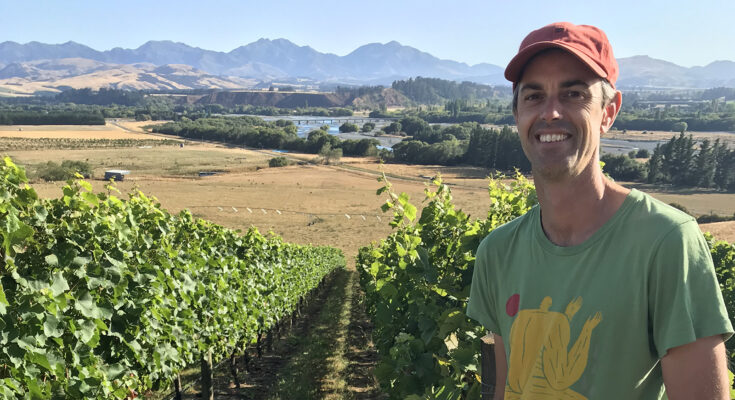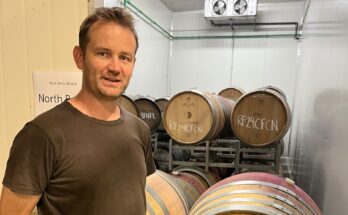Having met and briefly talked to Dom Maxwell at a visit to Greystone – where he is the Head Winemaker – earlier in the year, I’m also keen to catch up with him about his personal project Forager, plus the vineyard ferment projects generally… and anything else that’s going on over in North Canterbury.
With the situation of Aucklanders being captive inside the city boundaries to protect the rest of the country, I turned to the option of a virtual interview earlier this month. Something that doesn’t always work quite as planned..! (and true to form, we had “technical difficulties” on our first attempt)
DM: There – that’s working. Better than yesterday! What did you open last night? Enjoy anything nice?
WF: Errm, how can I put this? No, I was just working through some stuff that I had to do. Hahaha. It’s not always what I would choose to drink. And not everything you get sent hits the mark and makes it onto the website. The weekend is usually a bit better. I’ve dug through the crates and found a 2000 Gewurztraminer, so I’ll see what that is like.
DM: Oh yeah – from whereabouts?
WF: It’s an old Montana one – from the letter series. This one is a “P” from Gisborne I think. If I recall, I bought it at an auction for under $5.
DM: I hope you get your money’s worth!
WF: Otherwise I’ve got a couple of others to take a look at. The Chardonnay that won the Cuisine tasting – from Tohu, and the ‘Om Santi’ Chardonnay from Palliser, so I’m looking forward to that. And, I went off and found the notes from the time that I had a taste of the Forager Pinot – it was at First Glass on 25th May this year. It was wine number ten out of a lineup of eleven. You were sandwiched between a Thornbury Pinot Noir and a Prophet’s Rock ‘Home vineyard’ Pinot Noir. I’m not sure how many people knew what ‘Forager’ was. I had an inkling, of course. I wrote.. ”Dry, herbal, antiseptic, orange peel, blood orange, iron-earth, Dom Maxwell” – that’s my copious notes from two sips of Forager!
DM: Well, there you go. It is an interesting array of characters you get from that vineyard and I’ve only been working with it now for four years. But it has been around for a fair bit longer than that, but there’s still work to do in order to achieve ideal vine balance, you know. The fruit is naturally sugar-ripe probably slightly earlier than I would like. So I think there’s a bit of work to do around vigour and things like that on the site. Even though it’s on the side of a hill, facing north west, it is remarkably vigorous. Partly that is rootstock but also the ability of limestone to draw up water.
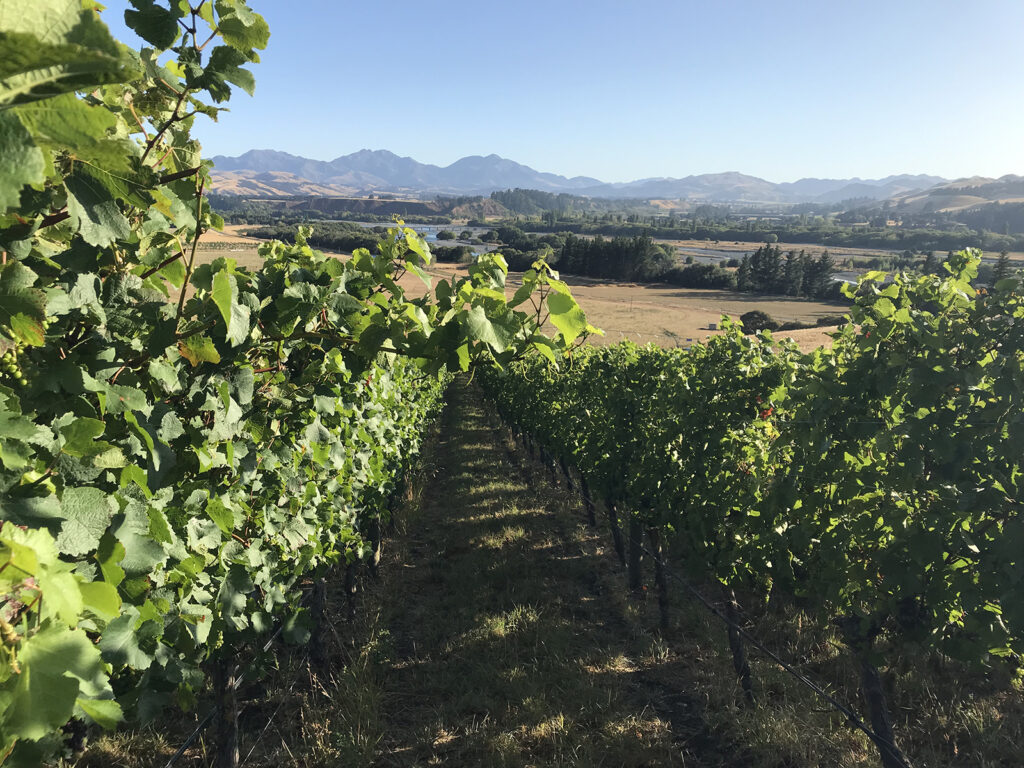
WF: Is it the only vineyard up there? I don’t recall hearing about vines up that way before?
DM: I believe there’s a couple of crazy accountants from Christchurch that have got a hobby block up there on a farm. I think it’s ten rows of Riesling. More to satisfy their thirst for knowledge than producing wine. The vineyard is the only true producing-vineyard for more than 30km. Probably the closest ones to it are the ones coming back down to Waikari. It’s called Isolated Hill, and it is almost straight north from where Waikari is. To get there you go through Waikari and Culverden, then take a turn as if you were going skiing at Mt Lyford, and it is just before the town of Waiau. The hillside is overlooking the Waiau River.
WF: Given that this is your ‘personal project’ – is there something special that’s drawn you to that place?
DM: Like a lot of things in wine, there’s a long story that goes with it. I started making Forager in 2012 and I was really fortunate in that when I mentioned it to the owners, and the crew, here at Greystone – that I’d love to have my own thing – that they were fully supportive. They actually allowed me to use fruit from the company vineyard for the first couple of years. That was a great way to get started, but I was looking for something that would be different. So even though I’m making it in a slightly different way, if the fruit had a different character… and it’s so hard to get fruit, and I was only after a small amount, you know. Generally if you’re only after a couple of tonnes, people aren’t interested, unless they’ve got a very small vineyard.
There wasn’t much around but I was at a wine dinner and having a yarn to someone, and they said “you want to go and check out Andy Black’s vineyard”.
The owners – Andy and Jill Black – have been farming there for quite a while, and back in 2000, I think, Mike Weersing knocked on their door and asked if they would consider planting grapes up there. They went into a bit of a partnership and planted grapes on the hillside of his farm. That lasted for a while, but the Weersings then concentrated on their home block, and Andy started selling grapes to other wineries. The fruit was sort of getting lost to big wineries, and he wanted to get a bit of his own wine back, and it was never really working. In his ideal world he’d be working with someone smaller. So I got his number and gave him a call.
Jeez, he’d be one of the most enthusiastic guys you’d ever come across. An infectious enthusiasm you know? He’s an old school farmer but he’s got a real positive attitude. And he loves wine. When he comes to the winery, he really thrives on that. It’s those sort of things that just add so much, and it’s what we love in wine. Bringing people from different walks of life together, really.
We had a chat on the side of the hill, and it was perfect for me because I didn’t want to take all the fruit, and he wanted a bit of his own wine – so make him a couple of barrels. We started on that and it is just on a handshake. Depending on the season we just divvy it out and he lets me take the best bite of the cherry, and he’s happy with the rest of the fruit. Like any block, there’s some more vigorous vines or areas that aren’t to the same quality.
He’s planted almost the same amount in Chardonnay just across on the same hillside. They’re about two years old now, so there will be a crop in 2023 which is cool. He wanted to plant Riesling, and I kind of wanted to say “do it” but although we love Riesling it’s kind of hard to sell it at a certain price. And when you’re growing in those conditions, the wine needs to be a certain price, because it costs a fair bit.
WF: We need more Chardonnay from North Canterbury! So there will be a Forager Chardonnay?
DM: I haven’t committed to it but I am definitely interested. And he’s relaxed about it. He must have a big group of friends because he seems to get through his allocation pretty quickly. I think they’ve got grown up kids that are getting married, and any opportunity for a party! Out it comes and they’ll put a few cases on the table.
WF: Did Forager start off doing the vineyard ferment?
DM: When I started Forager, I wanted to make it differently and was keen on the vineyard ferment idea. When I chatted with Nick Gill – who is our General Manager now, but he’s a viticulturist – he said “Why don’t we do the same at Greystone?”. So we did two – one for Forager and one for Greystone, and that’s carried on. For Forager that’s my one mode of fermenting.
It was interesting the first year I did it at Isolated Hill, because it is about 45 minutes away, and there’s a fair bit on over harvest. A friend of mine would go over and check it most days, plunge it and do some analysis and bring a sample back to the winery. On the weekends, Andy, the farmer, would just go and check it. Through that process we learnt that as long as the fruit is good, the ferment should be good, so there’s not a lot that you need to do.
So I became more and more hands-off with that, and in the following years I would get there once a week. Andy would go and look most days and give it a light plunge, just wetting the cap. He’s been around wine long enough to know that if something is not smelling right then there’s an issue. But if you’ve got good fruit there shouldn’t be an issue.
It is truly fermenting all by itself on the side of this hillside. But it shows you – and we’ve learnt a lot from these ferments – that we intervene because we can, and it is not always because we should. It stays up there for about a month, and then we drive over there with one of the winery guys and the trailer. Andy has this huge John Deere tractor and he’ll just pick up this whole fermenter and plonk it on the back of the trailer. We drive back and press it off into barrels.
WF: Has it gone well – does it have a good following?
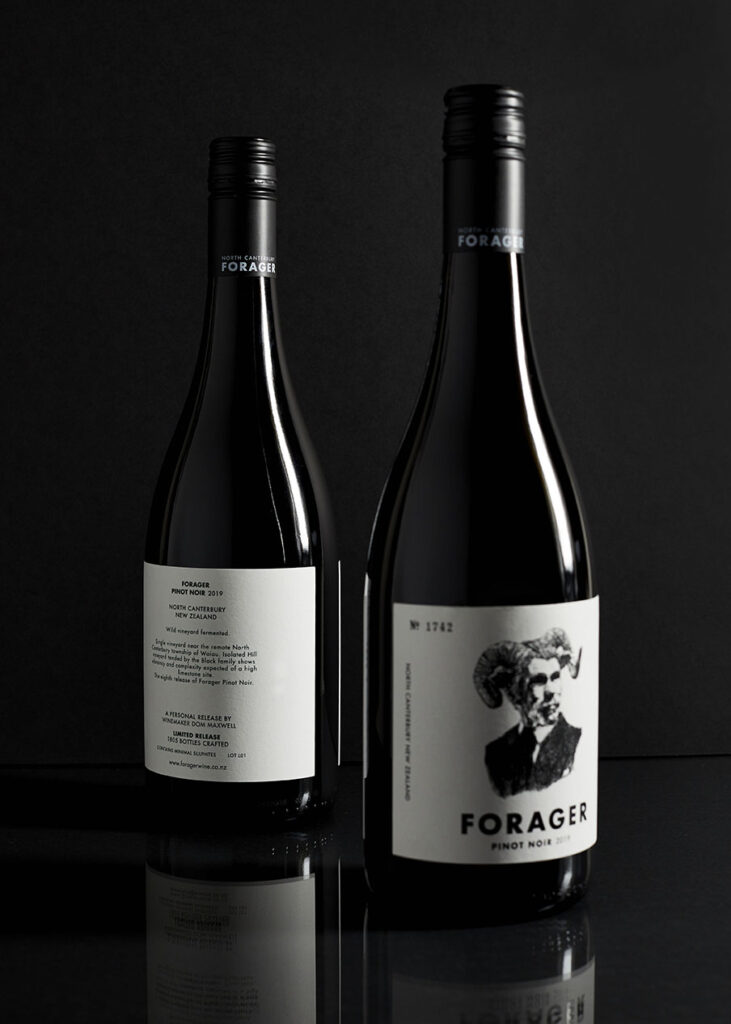
DM: Yes it has. I never wanted to be in a position where I had to push the wine. There’s plenty of other stuff I’d rather be doing. Being small volume I don’t have to push it too much. But the right people were finding out about it, and I’ll get contacted by people who’ve heard about it or saw it somewhere and want to buy it. It varies between maybe 150 and 300 cases depending on the vintage.
WF: How are the older ones looking?
DM: 2017 is still young – that was the first vintage from that vineyard. ’17 was a cool vintage so lots of vibrancy there – which you’d get from limestone as well. The earlier vintages which are from more of the clay hillsides on Omihi here, are still looking great.
They are wines that haven’t been worked, just had a little bit of sulphur post-malo, and barrels that have been used in the past as well. Every second year I’ve got about 10% new oak just so I can keep some freshness. From that limestone it would be great to leave the wines longer, but I’m not in that position to be able to store it for five years and then release it. But I am trying to encourage people to hold on to some.
WF: With the vineyard ferment style of doing it – have there been any downsides, or negatives? Or people saying that it’s just ‘being different for the sake of it’?
DM: I’ve thought about that, but not spent a lot of time on it – that people might just think that you’re trying to something a bit kooky. I’ve had plenty of people who have asked lots of questions. With Forager it was always small, and actually with Greystone it was never the intention to bottle it! It was four years before we released anything that had ‘Vineyard Ferment’ on the label.
It was just something interesting that we liked to do. There were just so many positive things that we were getting out of it – culturally, but also wine quality-wise. And we were learning heaps. Gradually it began to seep out that we were doing something like that here, and the interest just came flooding in. I think once people realised that we’d been tinkering away for years, doing something that interested us – and the wines were good.
The thinking behind it was the pied de cuves that a few people do. You pick a few bunches, put them in a bucket and squish them and leave them in the vineyard to get a wee natural ferment going. And then you bring it into the winery once your fruit starts to come in, and you add it to your fermenters as a way of inoculating. The conversations that we were having in the winery was that we’ve got two vineyards here and blocks at different elevations, and some near streams, some near olives or native plantings. So surely the type of yeast must vary? It doesn’t just stop at the farm gate and change at the next boundary. So how do we know what yeast is performing the fermentation? It was along those lines.
WF: Is there a way to identify that and capture that information?
DM: We’re actually two years into a three year study at the moment. We got some funding from Callaghan Innovation, and are collaborating at the moment with Lincoln University and a pHD student from Chile who has done a fair few vintages around New Zealand. She’s worked the last two vintages with us, and her main focus has been running our vineyard ferments and running replicates in the winery as well with the same fruit. Just everything being identical, and then doing testing – doing DNA sequencing, running microbial analysis. She’ll be starting to write her paper up from about March next year.
We already know there’s quite big differences, and one of the interesting things to come out of it that we hadn’t really contemplated was that difference in ambient temperature. It seems basic but at the time it was just all about the yeast.
Now that we’re measuring those at five minute intervals – the temperature inside the fermenter and the ambient temperature right outside. And winery versus vineyard. Just the variations are incredible. As you might expect, in the winery, the temperatures both follow nice bell curves. In the vineyard it is very different. Fermentation might kick off early, then drop down. And then hover away and take longer to finish. Or, we’ve had years where it takes almost two weeks to start ferment because it has been really cold outside. And the extremes of the vineyard – both warmer and colder temperatures. We’re getting different extraction and flavour profile in the winery versus the vineyard because of that. On top of the testing that she is doing, we’ll have blind panel tastings running over everything as well, just to critically compare.
WF: Is that even more of a factor over at Waiau?
DM: It is more exposed, but as per most things with Forager, I’m not really testing that! It is higher in elevation, it is further inland… so you’re getting colder weather, but on a warm day it is really hot there as well.
WF: Could you do a vineyard ferment of something like the Chardonnay up there?
DM: I don’t know personally. I’m not going to say a hard and fast Yes or No. It works really well with things on skins because the skins helps to stop any oxidation, whereas if you’re just fermenting juice? I feel there needs to be a higher level of attention day to day. It is something I’m mulling over – how does it fit with Forager? Can you make a vineyard-fermented Forager Pinot and then just make a winery-fermented Chardonnay to go beside it? The thing I like so far about Forager is there’s a simplicity to it. Wineries can be pretty complicated places, with different tiers and varieties and styles on those, so it can be hard for consumers to know what you’re up to. It’s nice and easy just having one wine.
WF: I guess what I was alluding to before was – the story behind the wine is really interesting, but at the end of the day what is in the glass is what will determine whether someone comes back and buys it again. Would someone just buy it once an then move on – like in a bar that serves craft beer, where customers are always after something new.. I always go in and ask “what’s new?”. I might buy my favourite one for when I’m at home, but the market is pretty full of different options, all the time.
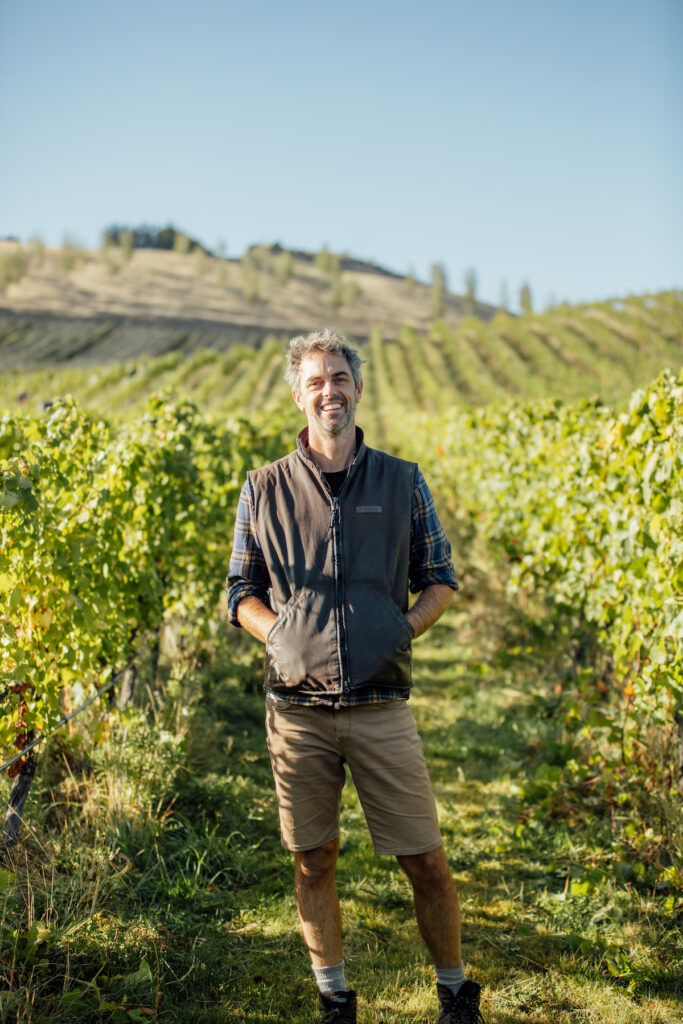
Dom at Greystone vineyard
DM: It does come down to what you said at the beginning – if it tastes good then people will come back if they feel they’re getting value for money and they’re enjoying the wine and everything that comes with it, and they will buy it again. One of the things we’ve accepted with vineyard ferment is that the wine will show the season very strongly. Which we love – but you all have to be on board with that you know? And it won’t be for every wine consumer, at all. But it will be for some – and they will love that journey.
We’ve been tentative with it – just a couple of barrels but we’re doing a bit more of it now. Export markets have been really keen on it. And I think that, in these days, there is a lot of good wine out there, but the fact that it is a little bit different allows it a bit of oxygen. It has to stand out for a reason.
I keep going back to the stuff that we’ve learnt from it, and one of the things that we love is that we can really talk to it. It is quite a tangible thing and we can talk about what it does to the fermentation and therefore what it does to the wine. And what it does to us, the differences we see and why it matters to you as a wine producer. We’re not just going to tell you what it tastes and smells like, but tell a story that has real depth to it. People can really grasp that. Sometimes you’ve got to take a photo or two to get across the fact that it’s actually out in the vineyard!
WF: What’s next – is there another project that you’d like to do?
DM: Well we’ve tried plenty. We read about some underwater wine about ten years ago, and we played around with making rosé underwater. It brought some pretty interesting qualities to the wine. But it also brought a lot of pressure to the barrels and we lost a couple due to explosions.
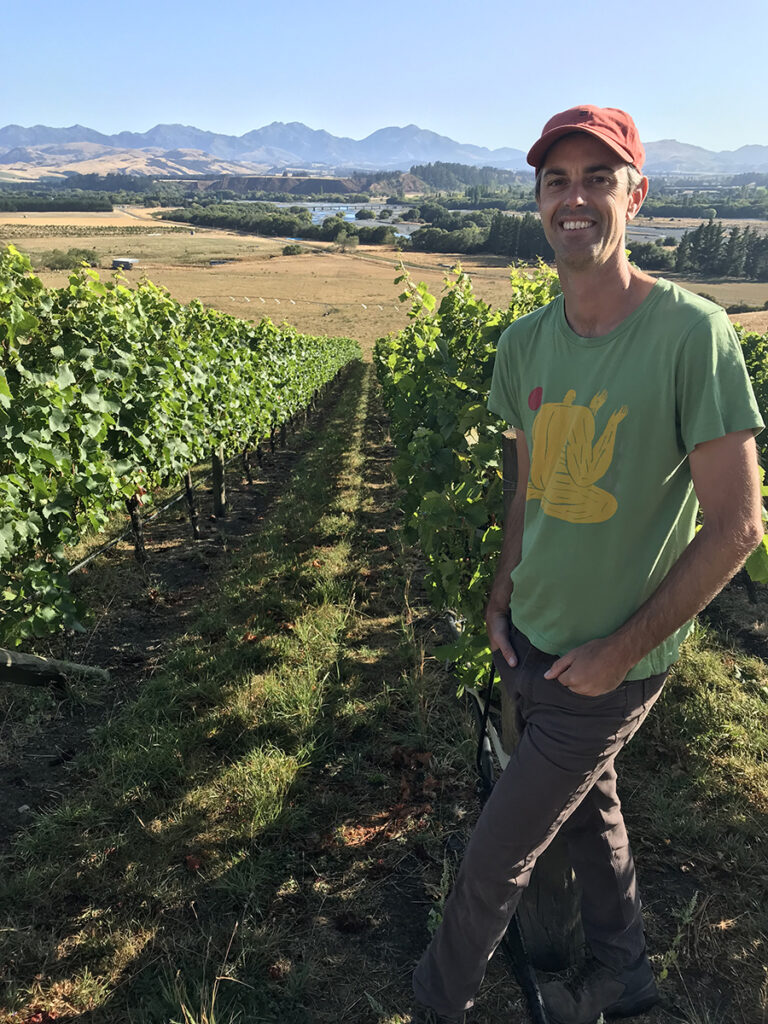
Another project that we’ve been working away on is on a small block that we’ve got planted by seed. About eight years ago we came across an organic vineyard that hadn’t been harvested for two seasons. And I was driving past and noticed some small seedlings underneath the vines. It was organic so it hadn’t been sprayed for a long time. It was at the end of the 2015 vintage which was really small and short for us, so we had a few people in the winery. So we got permission and went over with some spades and dug up around 3000. Potted them up, nurtured them and pruned them back. We planted some of them out about three years ago and not all survived. We’re trying to train them up but they’re really not very vigorous at all. We’re trying to get them to a point where we start to see some fruit.
It’s from a Riesling block, but it could be parents of Riesling – could be Gouais Blanc. Grapevines are pretty unstable things and it hasn’t been grafted to anything. It’s just an interesting little experiment. There’s a few things that we’re doing that are pushing boundaries. With the group of people that we have here, whenever we talk about something we always end up saying “well let’s try it then”. If we don’t know what the answer is, then we want to find out! We’ve got an owner who gives us heaps of autonomy, and it keeps people really engaged. I’m sure that’s why so many of our staff have been here for a long time.
We’re still quite new to this, in New Zealand, and we don’t yet know the best way. We know good ways, but don’t know if this is how things will be done in 50-100 years time?
WF: We’re discovering the New Zealand way – and that might not be the way that wine has always been made.
DM: Exactly. And because a lot was planted quite quickly, there’s a lot of uniformity around New Zealand. I’m sure things will change. Whether it is the clonal material, the trellising system, or the type of agriculture that’s used. I think it is quite an exciting time, because there’s a bit of experience now and people are starting to get the confidence to try some new things.

